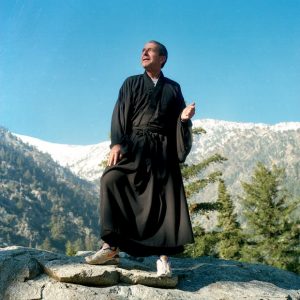Singer/Songwriter, poet, novelist Leonard Cohen died last last year. Those familiar with his work know that lyrics to his first half dozen albums come from familiarity with Talmudic teachings and Christian mysticism that map quite nicely on Thelemic perspectives on existence (i.e. numerous Qabalistic principles). He also studied Zen Buddhism for some 40 years under Kyozan Joshu Sasaki Roshi and moved to his monastery an hour NE of Los Angeles for many years. A commemorative piece Rolling Stone contains the following account of one of Cohen’s experiences while meditating:
“That day, Cohen’s rage gave way to a moment of unexpected grace, a kind of temporary epiphany. ‘There was sunlight on the floor of the cabin, where we were waiting to go see Roshi,’ he said. ‘There were leaves outside and the shadow of these leaves was on the floor. The wind moved, something moved, and I disappeared into this movement. . . . The whole scene blew up. A dog started barking, and I was barking. And everything that arose was the content of my being. Everything that moved was me. . . . In certain blessed moments, we experience ourselves as the reality that is manifesting as everything. There’s no “I am one with the universe,” which is the cheapest mystical slogan.’ Cohen paused. ‘There is that moment,’ he continued, ‘and it decides that life is worth living. I was barking with the dog, but there really was no dog.'”
Read the entire article here:
As to what Cohen experienced, perhaps these passages in Crowley’s 8 Lectures on Yoga are suggestive:
“12. The word Dhyana is difficult to define; it is used by many writers in quite contrary senses. The question is discussed at some length in Part I. of my Book IV. I will quote what I have written about it in conclusion:
‘Let us try a final definition. Dhyana resembles Samadhi in many respects. There is a union of the ego and the non-ego, and a loss of the sense of time and space and causality. Duality in any form is abolished. The idea of time involves that of two consecutive things, that of space two non-coincident things, that of causality two connected things.’
“13. Samadhi, on the contrary, is in a way very easy to define. Etymology, aided by the persistence of the religious tradition, helps us here. “Sam is a prefix in Sanskrit which developed into the prefix ‘syn’ in Greek without changing the meaning-‘syn’ in ‘synopsis,’ ‘synthesis,’ ‘syndrome.’ It means ‘together with.’
“‘Adhi’ has also come down through many centuries and many tongues. It is one of the oldest words in human language; it dates from the time when each sound had a definite meaning proper to it, a meaning suggested by the muscular movement made in producing the sound. Thus, the letter D originally means ‘father’; so the original father, dead and made into a ‘God,’ was called Ad. This name came down unchanged to Egypt, as you see in the Book of the Law. The word ‘Adhi’ in Sanskrit was usually translated ‘Lord.’ In the Syrian form we get it duplicated Hadad. You remember Ben Hadad, King of Syria. The Hebrew word for ‘Lord’ is Adon or Adonai. Adonai, my Lord, is constantly used in the Bible to replace the name Jehovah where that was too sacred to be mentioned, or for other reasons improper to write down. Adonai has also come to mean, through the Rosicrucian tradition, the Holy Guardian Angel, and thus the object of worship or concentration. It is the same thing; worship is worth-ship, means worthiness; and anything but the chosen object is necessarily an unworthy object.
“14. As Dhyana also represents the condition of annihilation of dividuality, it is a little difficult to distinguish between it and Samadhi. I wrote in Part I., Book IV.-
‘These Dhyanic conditions contradict those of normal thought, but in Samadhi they are very much more marked than in Dhyana. And while in the latter it seems like a simple union of two things, in the former it appears as if all things rush together and unite. One might say this, that in Dhyana there was still this quality latent, that the one existing was opposed to the many non-existing; in Samadhi the many and the one are united in a union of existence with non-existence. This definition is not made from reflection, but from memory.’
“15. But that was written in 1911, and since then I have had an immense harvest of experience. I am inclined to say at this moment that Dhyana stands to Samadhi rather as the jumping about like a frog, described in a previous lecture, does to Levitation. In other words, Dhyana is an unbalanced or an impure approximation to Samadhi. Subject and object unite and disappear with ecstasy mounting to indifference, and so forth, but there is still a presentation of some kind in the new genus of consciousness. In this view Dhyana would be rather like an explosion of gunpowder carelessly mixed; most of it goes off with a bang, but there is some debris of the original components.”
There is much talk of ecstatic states in the occult community though at times one questions how much is actually being experienced. So this account of someone achieving such a state is offered as encouragement to all of us who are still mainly aspiring.


